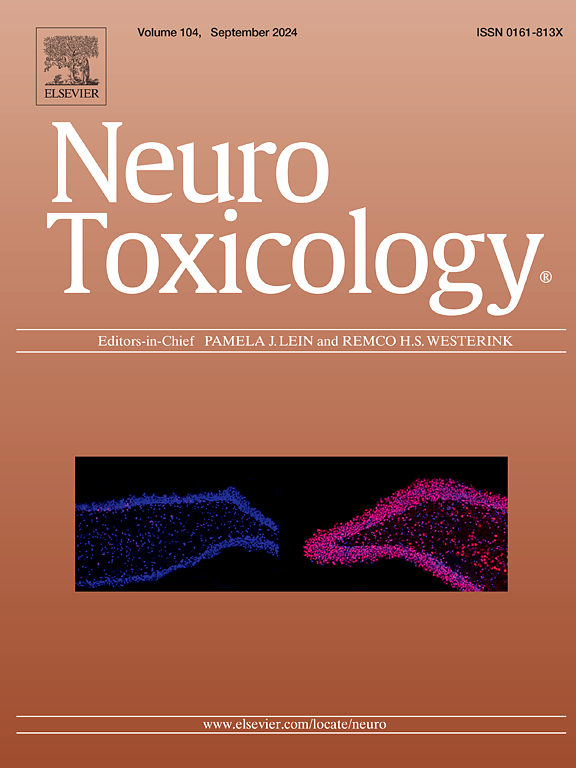A prospective study of a whole blood metal mixture and depressive symptoms among Black women from Detroit, Michigan
IF 3.9
3区 医学
Q2 NEUROSCIENCES
引用次数: 0
Abstract
Exposure to metals has been previously associated with depressive symptoms, but few studies have considered potential effects of metal mixtures. In addition, few previous studies have been conducted among Black women, who are disproportionately at risk for exposure to some metals and greater depression incidence and severity. We analyzed data from the Study of Environment, Lifestyle, and Fibroids (SELF), a prospective cohort study of reproductive-aged Black women from Detroit, to examine associations between a mixture of metals, metalloids, and trace elements (“metals”) and depressive symptoms (n = 1450). SELF participants self-identified as Black or African American and were 23–34 years of age at enrollment. We collected covariate information on structured questionnaires and whole blood samples at baseline. We quantified 17 metals in whole blood using inductively coupled plasma mass spectrometer triple quadruple or Direct Mercury Analyzer-80. Participants reported depressive symptoms on the Center for Epidemiologic Studies Depression Scale (CES-D) at the 20-month follow-up visit, where higher CES-D scores reflected greater depressive symptoms. We used quantile-based g-computation to estimate the cumulative association of the metal mixture with CES-D scores, adjusting for age, household income, educational attainment, body mass index, smoking status, alcohol intake, and parity. We estimated beta coefficients (with 95 % confidence intervals [CI]) as the percent difference in CES-D scores per quartile increase in all metals. A one-quartile increase in the metal mixture was associated with 14.8 % lower (95 % CI=-26.7 %, −1.1 %) CES-D scores, reflecting lower depressive symptoms. The mixture association was driven by nickel, copper, cesium, molybdenum, and lead. Other neurotoxic metals (cadmium, arsenic, mercury, chromium) were associated with greater depressive symptoms. Findings from this study suggest that exposure to a mixture of metals may affect depressive symptoms in Black women, with individual metals acting in opposing directions.
全血金属混合物与密歇根州底特律黑人妇女抑郁症状的前瞻性研究
此前,接触金属与抑郁症状有关,但很少有研究考虑到金属混合物的潜在影响。此外,此前没有对黑人女性进行过研究,她们暴露在某些金属环境中的风险不成比例,抑郁症的发病率和严重程度也更高。我们分析了来自环境、生活方式和肌瘤研究(SELF)的数据,这是一项来自底特律的育龄黑人妇女的前瞻性队列研究,以检查金属、类金属和微量元素(“金属”)的混合物与抑郁症状之间的关系(n=1,450)。SELF参与者自认为是黑人或非裔美国人,在登记时年龄为23-34岁。我们收集了结构化问卷和基线全血样本的协变量信息。采用电感耦合等离子体质谱仪三联四联或直汞分析仪-80对全血中的17种金属进行了定量分析。在20个月的随访中,参与者在流行病学研究中心抑郁(CES-D)量表上报告抑郁症状,ce - d得分越高,抑郁症状越严重。我们使用基于分位数的g计算来估计金属混合物与CES-D分数的累积关联,调整了年龄、家庭收入、受教育程度、体重指数、吸烟状况、酒精摄入量和胎次。我们估计β系数(95%置信区间[CI])为所有金属中每四分位数的CES-D分数增加的百分比差异。金属混合物每增加四分之一,ce - d评分降低14.8% (95% CI=-26.7%, -1.1%),反映抑郁症状降低。混合缔合是由镍、铜、铯、钼和铅驱动的。其他神经毒性金属(镉、砷、汞、铬)与更严重的抑郁症状相关。这项研究的结果表明,接触混合金属可能会影响黑人妇女的抑郁症状,个别金属的作用方向相反。
本文章由计算机程序翻译,如有差异,请以英文原文为准。
求助全文
约1分钟内获得全文
求助全文
来源期刊

Neurotoxicology
医学-毒理学
CiteScore
6.80
自引率
5.90%
发文量
161
审稿时长
70 days
期刊介绍:
NeuroToxicology specializes in publishing the best peer-reviewed original research papers dealing with the effects of toxic substances on the nervous system of humans and experimental animals of all ages. The Journal emphasizes papers dealing with the neurotoxic effects of environmentally significant chemical hazards, manufactured drugs and naturally occurring compounds.
 求助内容:
求助内容: 应助结果提醒方式:
应助结果提醒方式:


